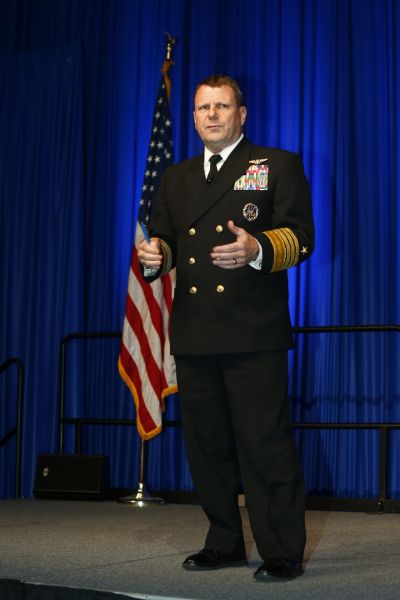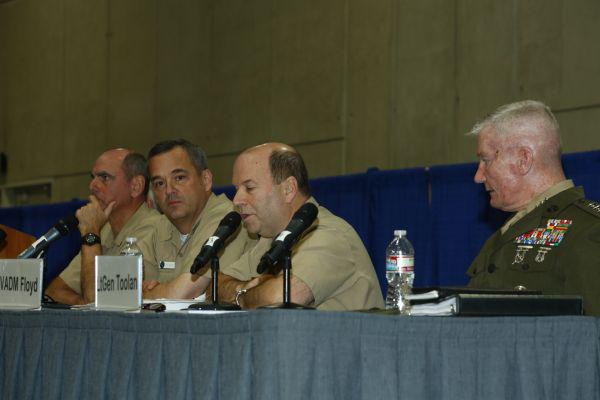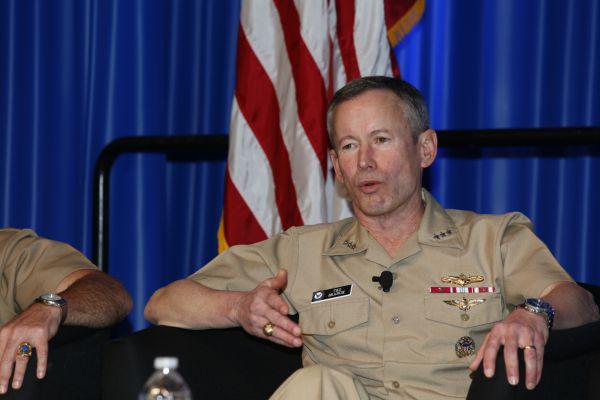Technologies Offer Hope for Navy Operations
West 2014 Online Show Daily, Day 2
Quote of the Day:
“We can complain, or we can lead. We’re choosing to lead.”—Adm. William E. Gortney, USN, commander of the U.S. Fleet Forces Command
As with the other military services, the U.S. Navy is looking to technology to help it fulfill its mission obligations in a time of severe budget constraints. Commercial technologies may provide effective solutions at a fraction of their military counterparts; innovations promise to add advanced capabilities to existing platforms; and new readiness plans may help economize deployments while increasing effectiveness.
However, a lot of plans must fall into place for these technologies to take their places in the force. Costs could be an obstacle for them as well. And, the changing nature of global challenges could place even greater strains on operational capabilities.
The second day of West 2014 in San Diego featured discussions of opportunities and obstacles facing the Navy as it deals with the dual challenge of greater mission obligations and sharply reduced funding. As always, cyberspace played a key role in discussions about future warfighting and mission support.
Information dominance is the Navy’s goal of cyberspace exploitation, and Vice Adm. Ted Branch, USN, the deputy chief of naval operations for information dominance and intelligence, held back little in emphasizing its importance. “Information is a warfighting domain, just like air, sea, land and space,” he declared. “And, being successful there is as important as it is in air, sea, land and space.”
Rear Adm. Paul Becker, USN, J-2, The Joint Staff, called for transforming data into a weapon system. However, he noted that there is no unique Joint Staff perspective for information dominance.
The chief information officer (CIO) of the Marine Corps took information dominance a step further. Brig. Gen. Kevin Nally, USMC, who also is the director for command, control, communications and computers for the Marine Corps, said the Corps is trying to take information dominance to the next level: knowledge dominance. The Corps has contracted with three commercial teleports around the world so that Marines can have immediate access to voice, video and data without needing to ask for permission. This will allow the Marine commander and the private first class on the ground to make knowledge-based decisions, Gen. Nally said.
With its advantages, cyberspace also brings hazards. Rear Adm. James Rodman Jr., USN, chief engineer, Space and Naval Warfare (SPAWAR) Systems Command, warned that the United States no longer can control the virtual realm that it created and then turned over to industry years ago. As a result, the United States no longer has the asymmetric advantage it possessed for many years.
“Can we dominate that artificial world that we created?” he asked.
The admiral suggested that experts need to stop looking at systems in isolation. Systems all have been connected, so experts must think about them in an enterprise perspective. Also, planners must consider what cyberspace will look like in five years. Then, that outlook must be built into systems.
Terry Halvorsen, Navy CIO, noted that cyber funding will increase, but it must be balanced between commercial gear and custom military products. This balancing must be implemented across the information technology realm.
“We are going to be in a declining resource environment,” Halvorsen said. This will require understanding the value of all data from all aspects.
Halvorsen suggested that the Navy would reduce spending on business information technology to allow funding for operational technology. “We spend a lot of money on business IT [information technology],” he said. “That has to come down.
“We must be ruthless on the business side—‘what do you bring me?’” he suggested as criteria. If a system or software is achieving mission minimums at a good price, then that should be left in place.
Cyber is just one technology on which the Navy is relying to improve its capabilities. Vice Adm. Thomas H. Copeman III, USN, commander, Naval Surface Forces, stated that the future Navy will resemble the existing one to a substantial degree. “The surface fleet we have sitting in the harbor now is the surface fleet we will have 15-20 years from now,” he predicted.
The way the Navy can advance its capabilities on existing platforms is by implementing innovative technologies. Admitting that he is concerned about the Navy’s ability “to recapitalize the punch of the surface fleet,” Adm. Copeman called for investments in electromagnetic rail guns and solid state lasers that can replace existing shipboard defense weapons.

Adm. William E. Gortney, USN, commander of the U.S. Fleet Forces Command, describes the new optimized fleet readiness plan.
Unmanned systems also are in the ascendancy, noted Rear Adm. Robert Hennegan, USN (Ret.), former commander of the Naval Mine and Anti-Submarine Warfare Command. However, they have grown in popularity so quickly they are beginning to suffer from drawbacks that have plagued other successful systems.
Saying that unmanned systems of all types in each domain will be an integral part of the high-end war fight, Adm. Hennegan warned that the military risks unintentionally creating information stovepipes among these unmanned systems. He called for a common architecture with common software and possibly common sensors. If a common display can be developed for unmanned systems, it would be viewable by personnel in each of the services without requiring any specialized training. The admiral cited a need for “COTS [commercial off-the-shelf] for robots.”
Amid these proposed technology improvements, one saving grace for the future Navy may be a revamped readiness plan. Adm. William E. Gortney, USN, commander of the U.S. Fleet Forces Command, described how a new optimized fleet response plan would standardize the readiness cycle and improve efficiencies among disciplines ranging from supply and maintenance to deployment. The new plan is the command’s response to the challenge of doing more with less funding without sacrificing capability or mission obligations.
“We can complain, or we can lead,” the admiral offered. “We’re choosing to lead.”
Coming up on the final day of West 2014:
A keynote panel on industrial base issues; a luncheon town meeting discussing a new maritime strategy; and a panel titled, “What About China?”





Comment
What a joke
This entire Information Dominance discussion is a joke. With Obama reducing the budget, the increased cyber attacks, extensive roadblocks with DITPR-DON, NAV_IDS, DADMS, and RMF, the attacks will continue.
These admirals and generals and congress and president have no clue. This is more of a dog and pony show. These supposed business system audits are a dog and pony show. It is utter confusion, no communication, and they keep hiring more government folks with no experience and putting them in these high level position and in turn it gets even more screwed up.
The DOn CIO says no RIF in the next 2 years. Ha! I can see the writing on the wall a mile away.
What a joke
Oh, so our contracting folks say we must continue to use the ESI contract for all IT software and hardware purchases. So does this mean that we can now lay off every contracting officer in the DoD because we now have a centralized purchasing area? Does this mean that every small, medium, and large business owner must now shutdown shop because their will be no more bidding on IT hardware and software purchases?
In order to create jobs, you must successfully support the small, medium, and large businesses, which in turn, create jobs, generate tax revenue, and pull our economy out of the gutter. This administration and its patsies are intentionally destroying our nation with all of these mechanisms being put into place.
Everyone is afraid to speak up about it. Not me. The thought processes involved with some of these people is utter madness. This is like the housing bubble. Its about to burst, and don't say I didn't tell you.
After listening to the DON CIO speak, all I heard was bla bla bla, Im just trying to finish my time so I can retire and keep congress and the president off my back.
"Technologies Offer Hope for Navy Operations"
Seems to me with so much emphasis on "cyberfunding, cyberwarfare, and information domain " just as important air, sea, land and space domain", USG/DOD/DefenseContractors better start re-shoring the sources of: semiconductors, electronics components, computers/displays/memories/harddisks communications(commercial off-the shelf dual-use). Further, avionics.missiles circuits, jet engine electronic controls, shipboard/airborne/space et al electronic components supplied from Asia (including bogus Chinese parts). . IBM deals with Lenovo as well as a host of others has eroded decades of DOD R&D/Manufacturing Investment. Hope DOD recommended against this wholesale export licensing of this technology. ENOUGH !
Admiral Tim Copeman
Tell Admiral Tim Copeman to materialise me with a satellite to talk and invest in the Navy. He will understand what I mean by materialise with satellite. This is very important
Comments